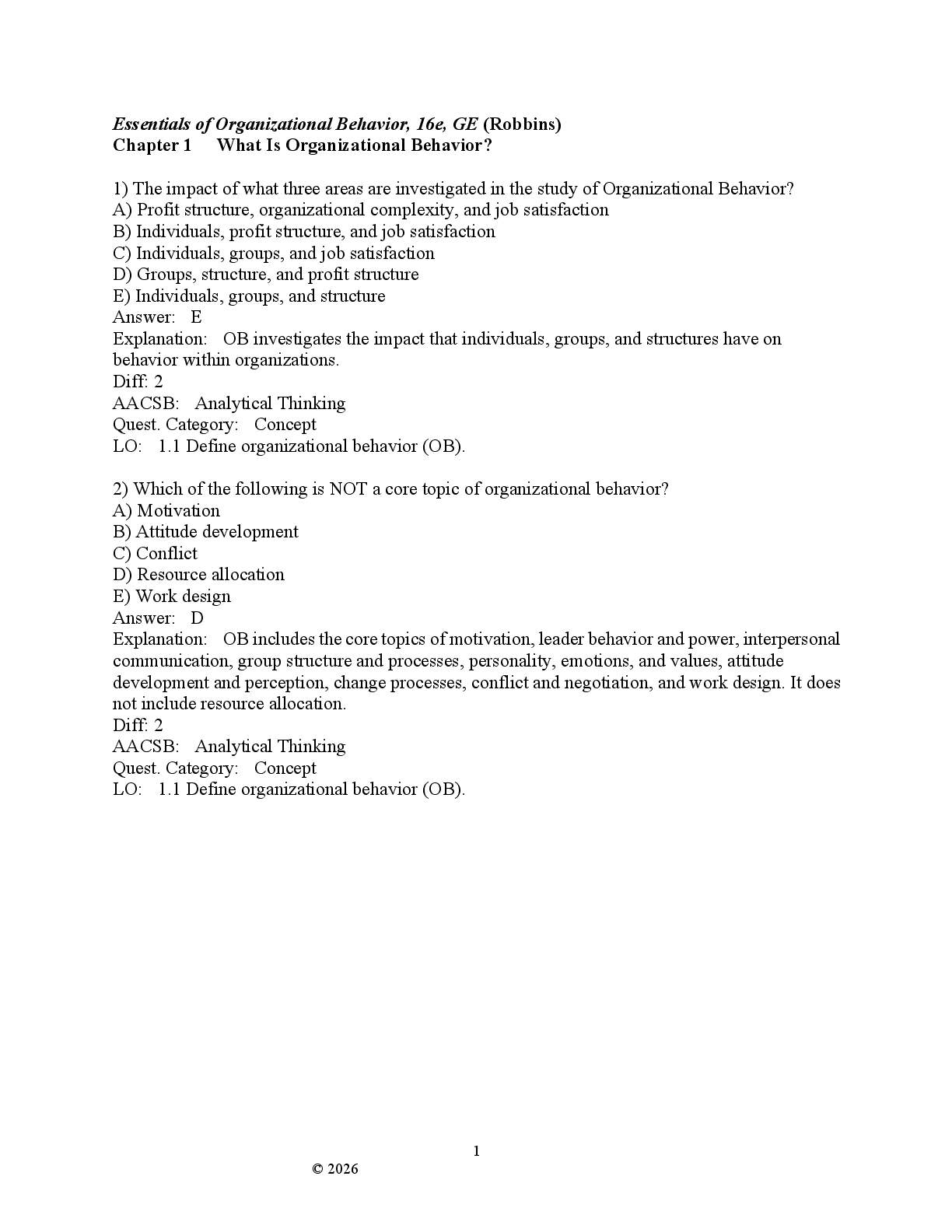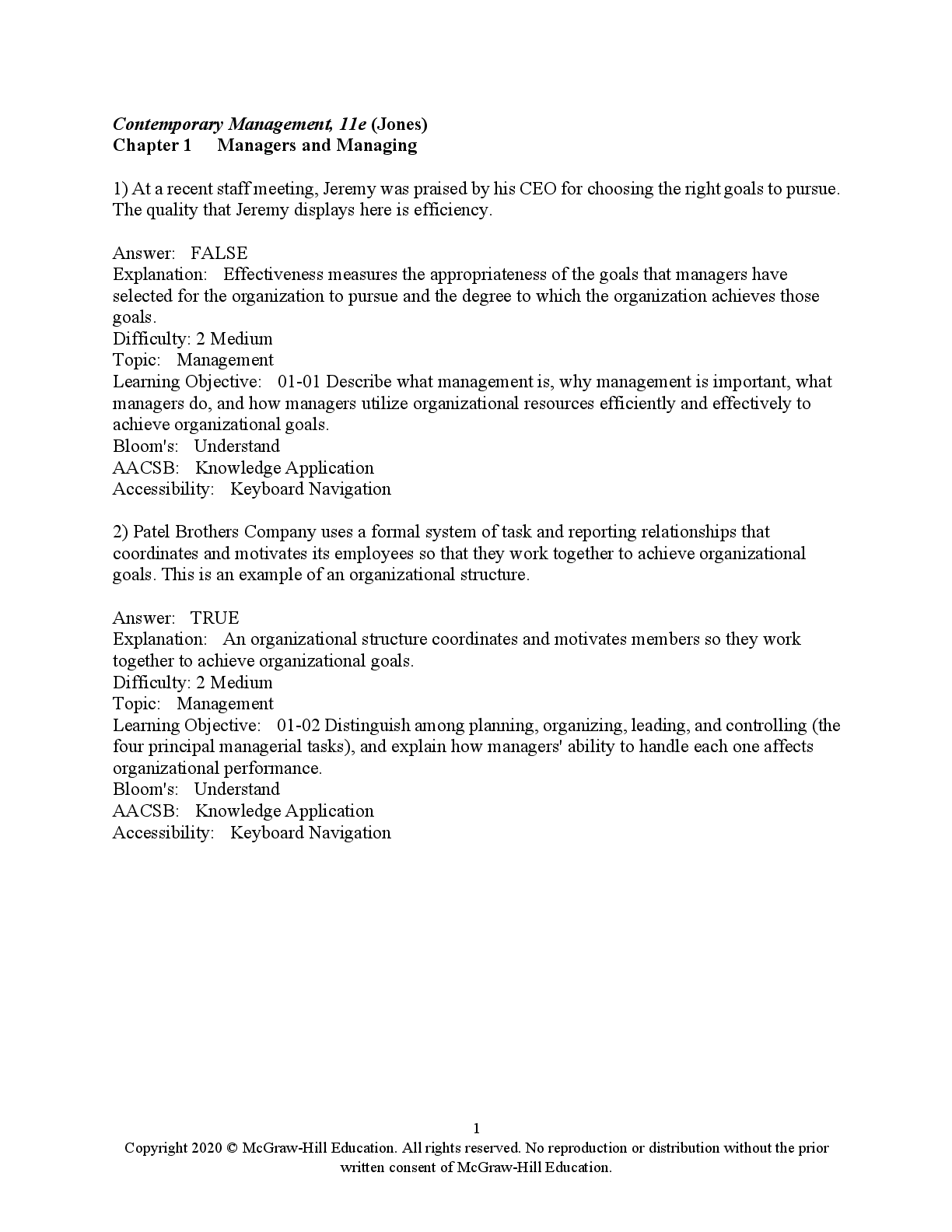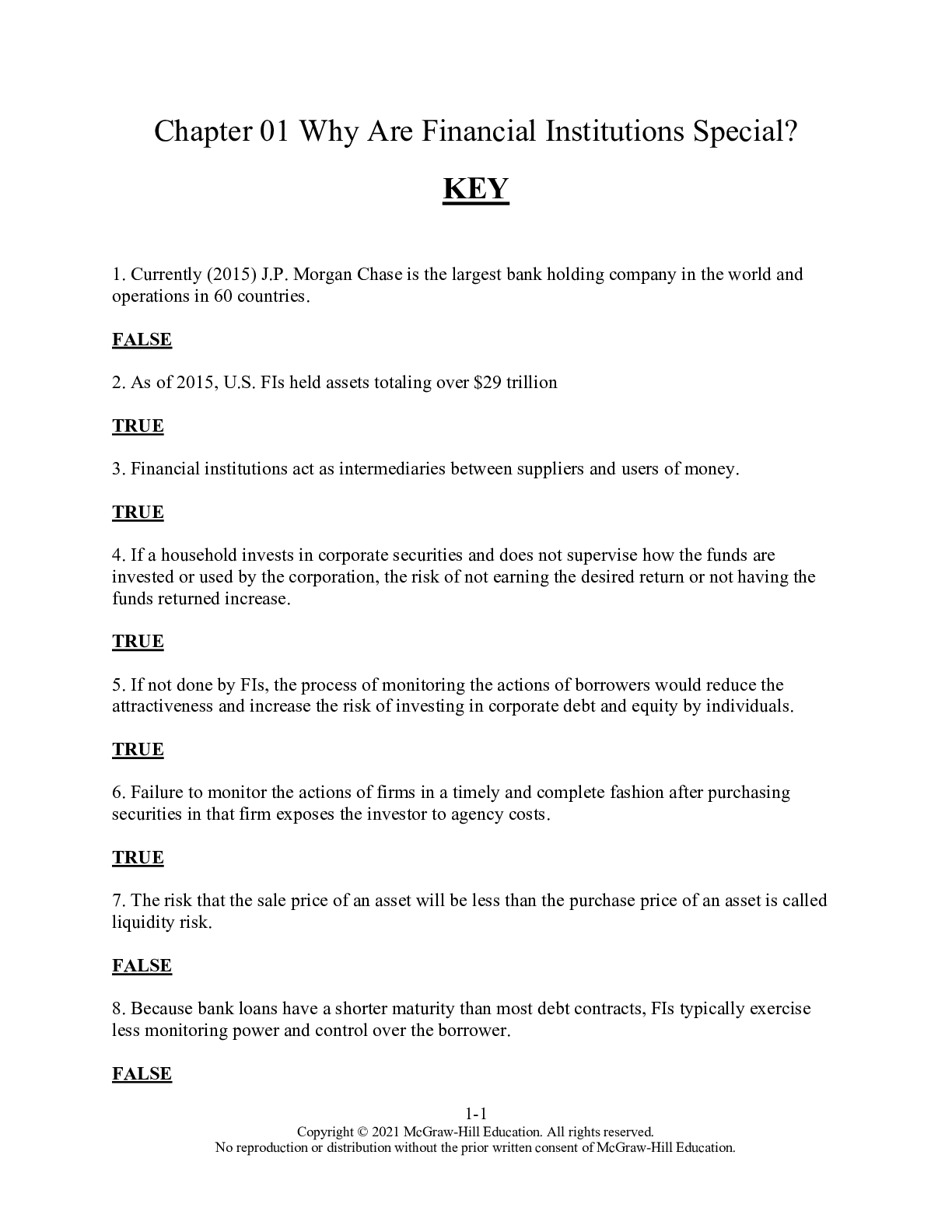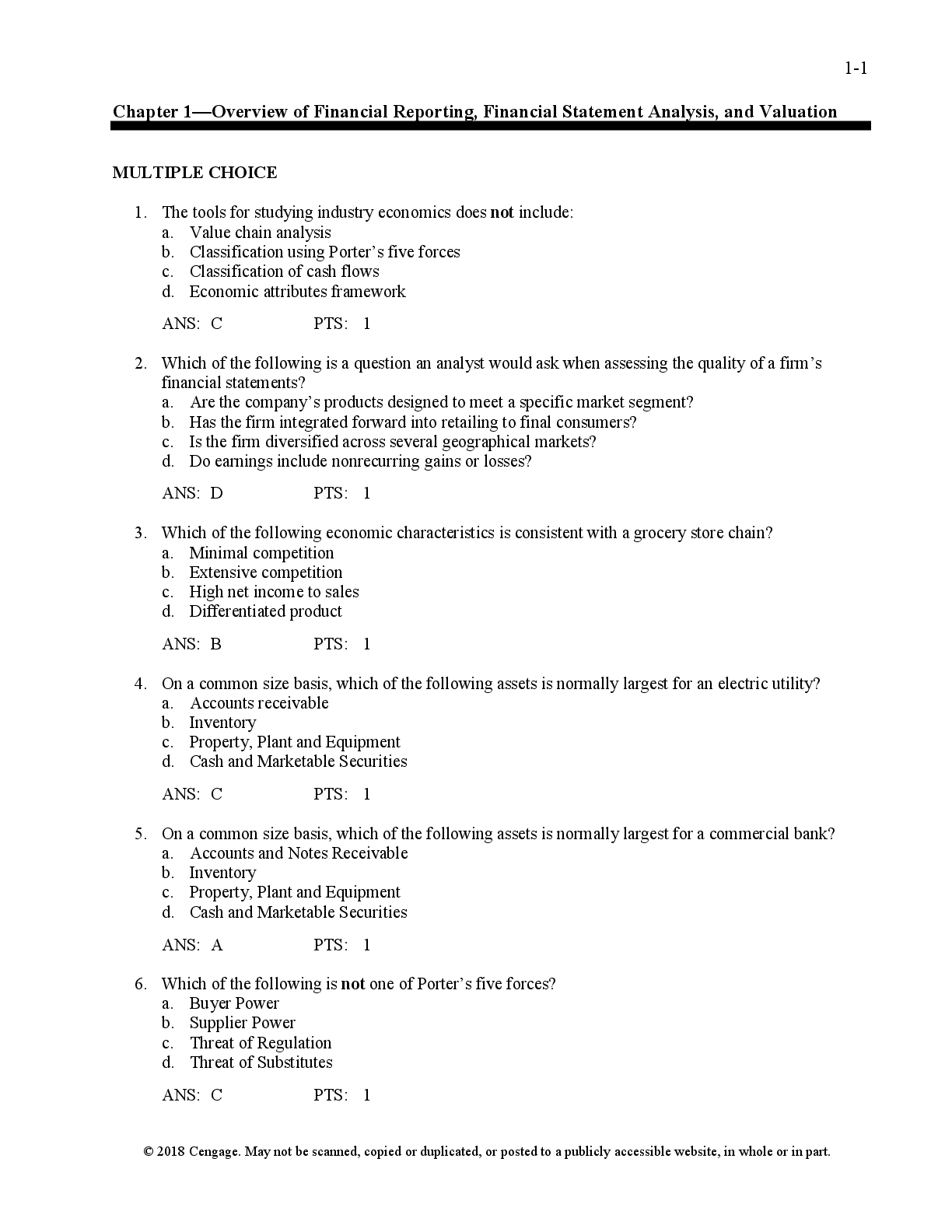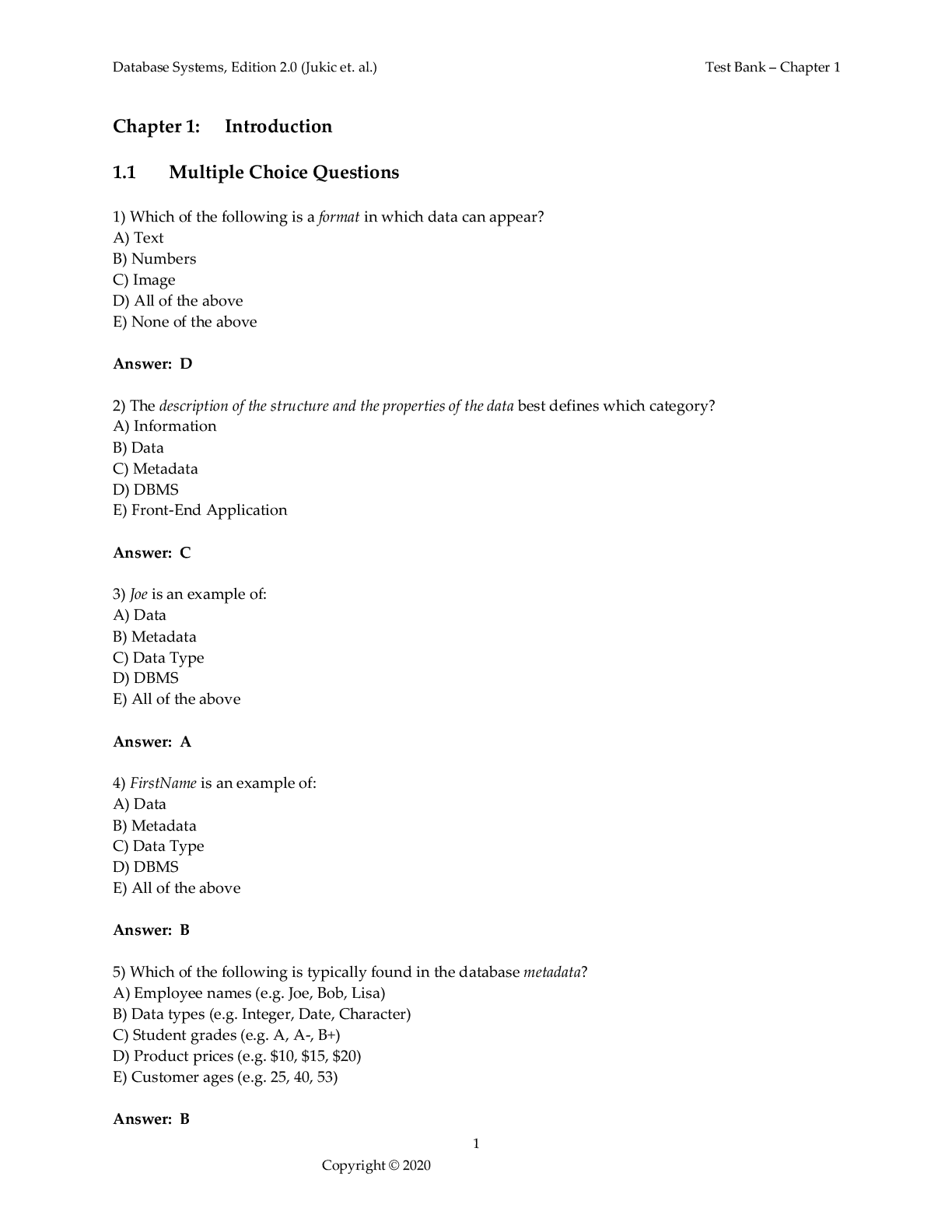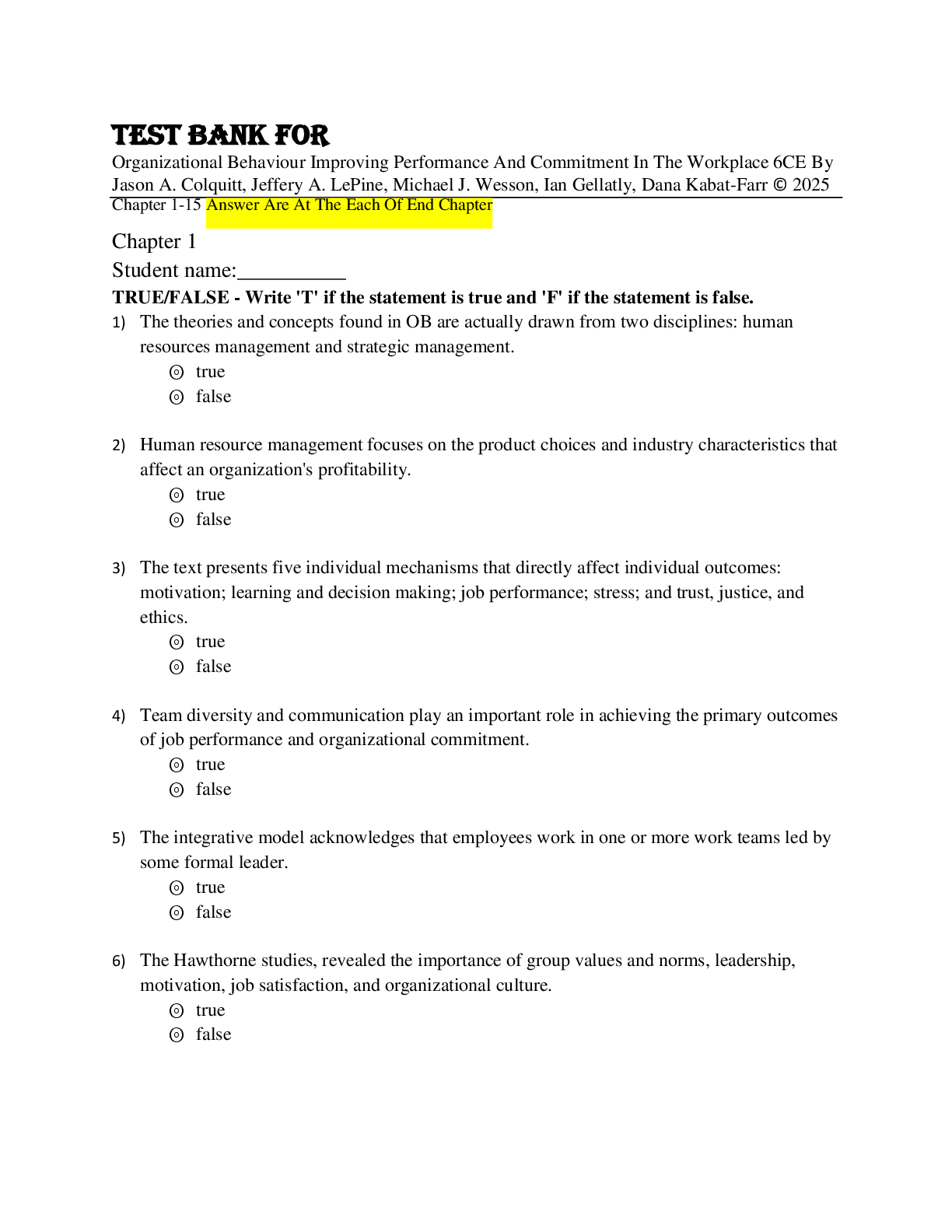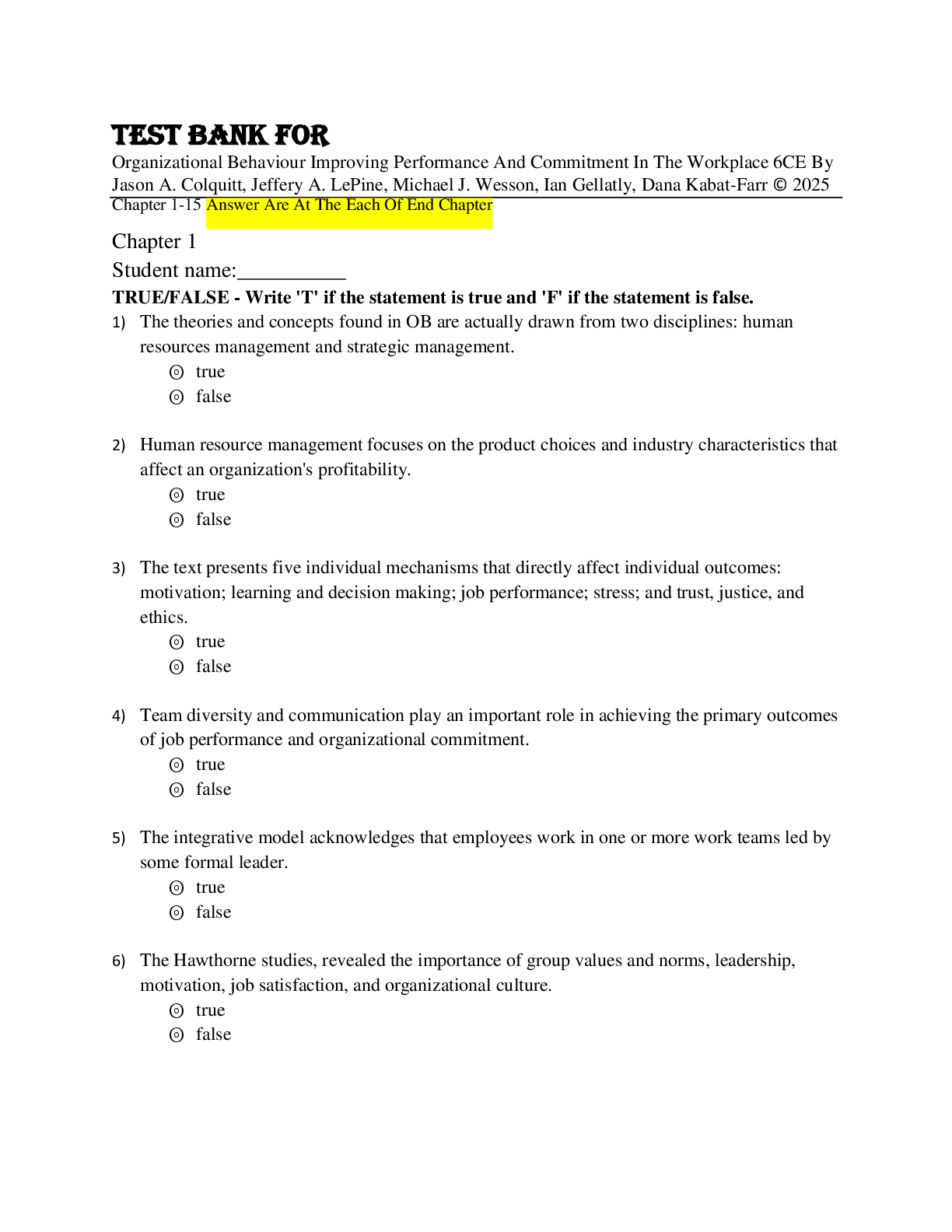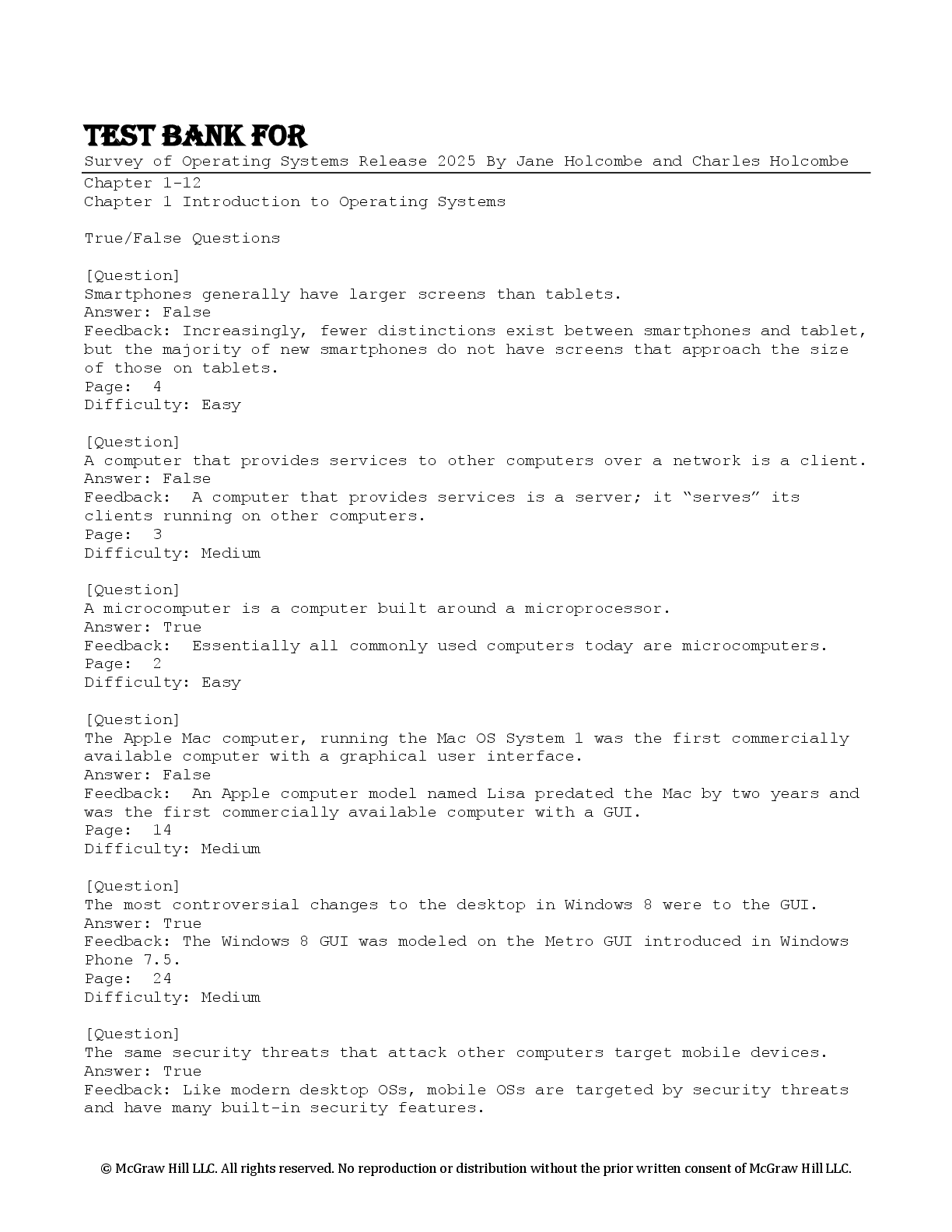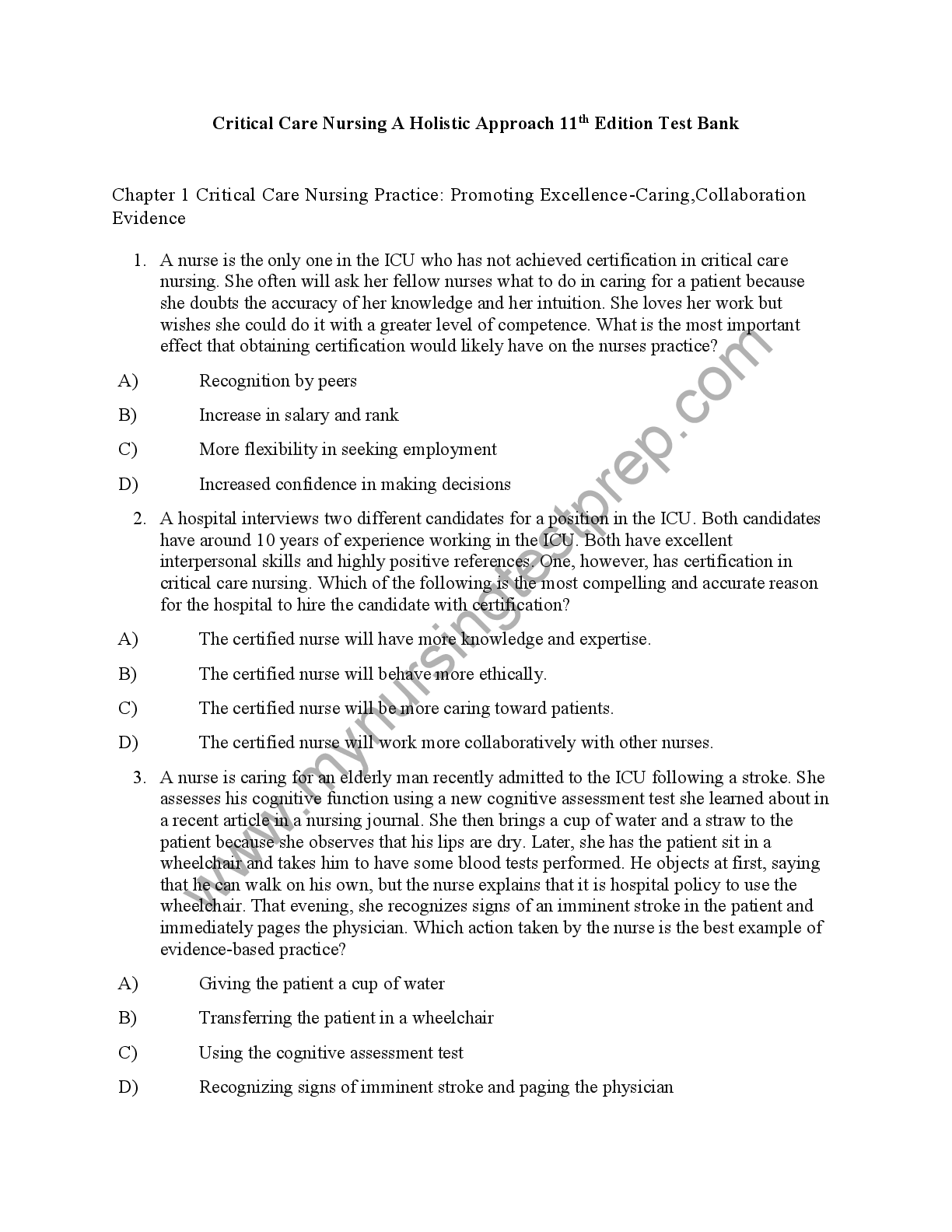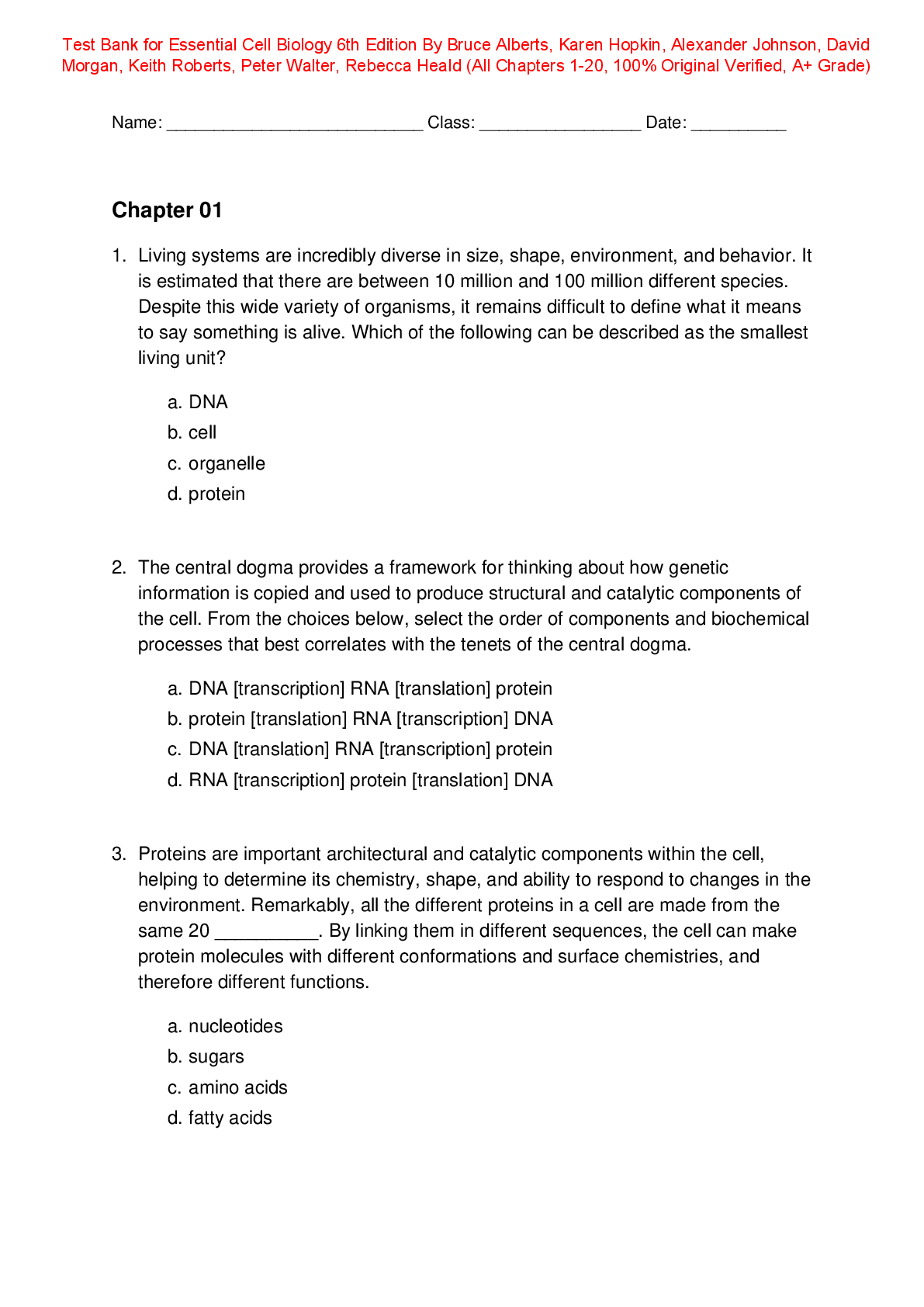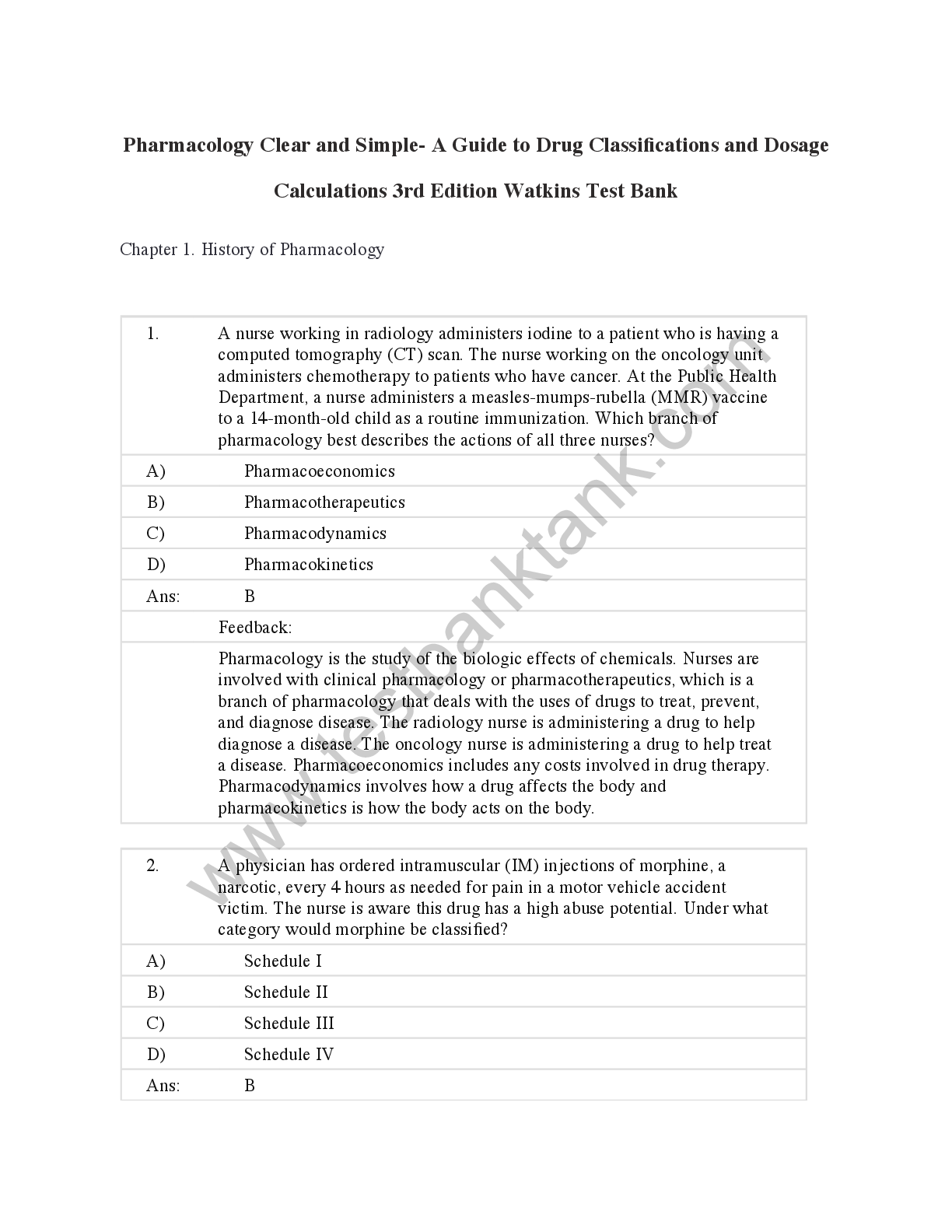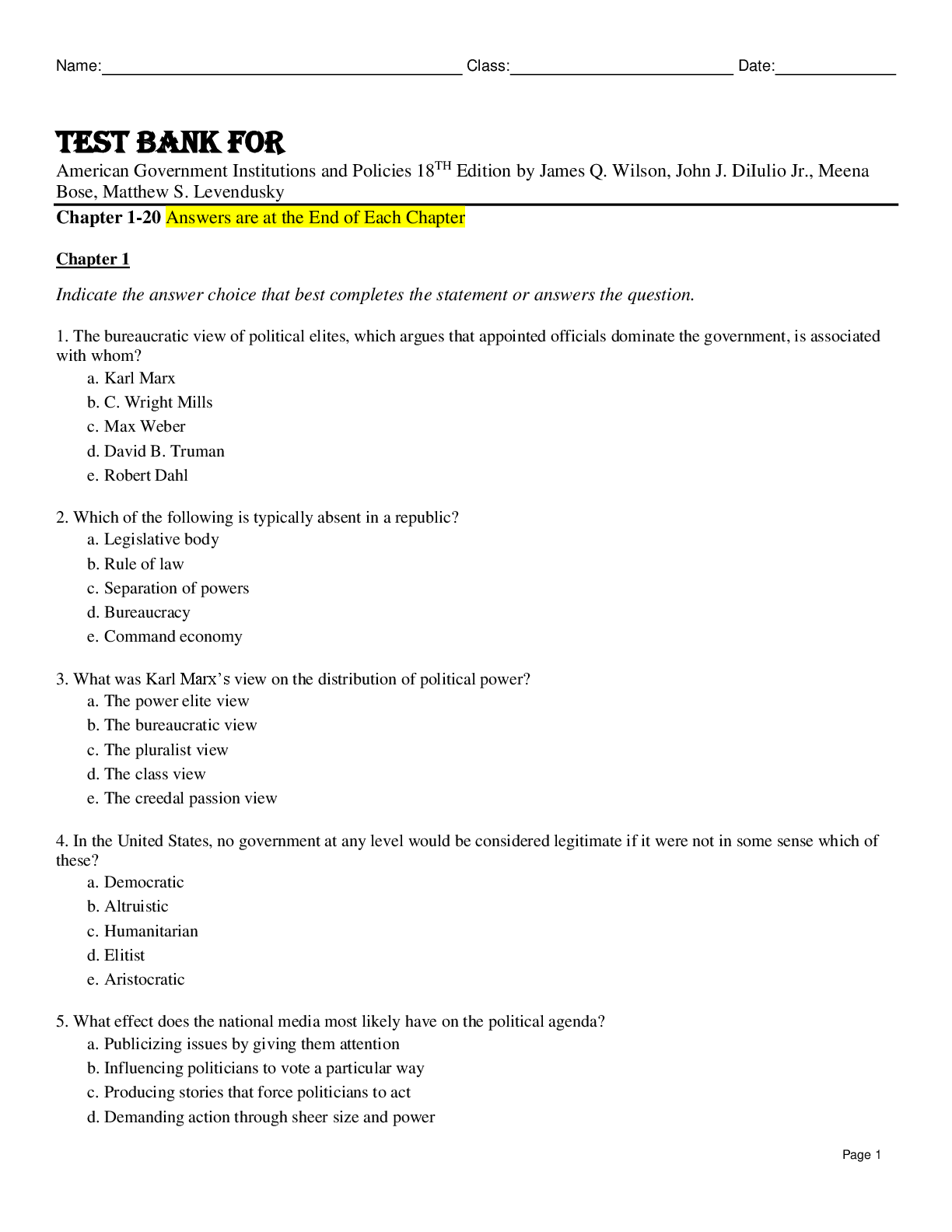Anthropology > TEST BANKS > Biological Anthropology: The Natural History of Humankind, 4th edition by Craig Stanford, Allen & An (All)
Biological Anthropology: The Natural History of Humankind, 4th edition by Craig Stanford, Allen & Antón TEST BANK
Document Content and Description Below
Test Bank for Biological Anthropology: The Natural History of Humankind, 4E, 4th Edition by Craig Stanford,John S. Allen,Susan C. Anton TEST BANK ISBN-13: 9780134007199 Full chapters included PAR ... T I: Mechanisms of Evolution Chapter 1: Origins of Evolutionary Thought What Is Science? The Early Thinkers The Roots of Modern Science Linnaeus and the Natural Scheme of Life The Road to the Darwinian Revolution COMTE DE BUFFON GEORGES CUVIER GEOFFROY SAINT-HILAIRE JEAN-BAPTISTE LAMARCK THE UNIFORMITARIANS: HUTTON AND LYELL The Darwinian Revolution The Galápagos Refining the Theory of Evolution by Natural Selection ALFRED RUSSEL WALLACE INSIGHTS AND ADVANCES: Darwin versus Wallace? The Response to Darwin Science and Creationism INSIGHTS AND ADVANCES: What Is Intelligent Design? Summary Review Questions Key Terms Chapter 2: Genetics: Cells and Molecules Genetics The Study of Genetics Genetic Metaphors: Blueprints, Recipes, or What? The Cell Cell Anatomy INSIGHTS AND ADVANCES: Cloning Controversies DNA Structure and Function DNA Structure I: The Molecular Level DNA Function I: Replication DNA Function II: Protein Synthesis DNA Structure II: Chromosomes and Cell Division MITOSIS INNOVATIONS: The Wide World of RNA INSIGHTS AND ADVANCES: Biochemical Individuality MEIOSIS DIFFERENT KINDS AND NUMBERS OF CHROMOSOMES CHROMOSOMAL ABNORMALITIES Molecular Tools for Bioanthropological Research Indirect versus Direct Research Methods PCR, Mitochondrial DNA, and Ancient DNA MITOCHONDRIAL DNA ANCIENT DNA Summary Review Questions Key Terms Chapter 3: Genetics: From Genotype to Phenotype From Genotype to Phenotype The ABO Blood Type System Obesity: A Complex Interaction Mendelian Genetics Mendel’s Postulates Linkage and Crossing Over Mutation Point Mutation and Sickle Cell Disease Insertion and Deletion Mutations Mutations: Bad, Neutral, and Good X-Linked Disorders Mendelian Genetics in Humans Genetics beyond Mendel Polygenic Traits, the Phenotype, and the Environment INSIGHTS AND ADVANCES: Popular Mendelism and the Shadow of Eugenics Heritability and IQ Test Score Performance Phenylketonuria: Illustrating Mendelian and Post-Mendelian Concepts INNOVATIONS: A New Genetic Era Genes and Environments Summary Review Questions Key Terms Chapter 4: The Forces of Evolution and the Formation of Species How Evolution Works Where Does Variation Come From? How Natural Selection Works Other Ways by Which Evolution Happens GENE FLOW GENETIC DRIFT SEXUAL SELECTION: DARWIN’S OTHER GREAT IDEA Classification and Evolution Taxonomy and Speciation What Is a Species? A Guide to Species Concepts Reproductive Isolating Mechanisms The Origin of Species: How Species Are Formed INSIGHTS AND ADVANCES: What’s in a Name? Species Concepts, Genetics, and Conservation The Tempo of Speciation Adaptation Hardy–Weinberg Equilibrium Levels of Selection Inclusive Fitness Summary Review Questions Key Terms Chapter 5: Human Variation: Evolution, Adaptation, and Adaptability Human Variation at the Individual and Group Level What Is a Population? Historical Perspectives on Human Variation Recording Human Variation in Past Civilizations The Monogenism–Polygenism Debate Race and Racism in the Twentieth Century Changing Attitudes Toward Race in Anthropology Deconstructing Racial Features SKIN COLOR EYE FORM HAIR COLOR AND FORM HEAD SHAPE Population Genetics Polymorphisms: ABO and Other Blood Type Systems MATERNAL–FETAL INCOMPATIBILITY THE HUMAN LEUKOCYTE ANTIGEN (HLA) SYSTEM Gene Flow and Protein Polymorphisms GENE FLOW IN CONTEMPORARY POPULATIONS MORPHOLOGICAL FEATURES AND GENE FLOW INNOVATIONS: Bermuda: Population Genetics of One of the Last Places Settled by People Polymorphisms and Phylogenetic Studies CONSTRUCTING A PHYLOGENETIC TREE A GENETIC TREE OF THE WORLD’S POPULATIONS Polymorphisms and Natural Selection in Human Populations The Evolution of Lactose Tolerance THE GENETICS OF LACTASE PRODUCTION EXPLANATIONS FOR THE LACTASE POLYMORPHISM Balanced Polymorphisms: Sickle Cell and Other Conditions HETEROZYGOUS ADVANTAGE OTHER POSSIBLE DISEASE-ASSOCIATED BALANCED POLYMORPHISMS Adaptation and Adaptability Levels of Adaptability Heat and Cold INSIGHTS AND ADVANCES: Technology and Extreme Environments Body Size and Shape Living at High Altitude Skin Color ADVANTAGES AND DISADVANTAGES OF LIGHT AND DARK SKIN COLOR EVOLUTIONARY SYNTHESIS Summary Review Questions Key Terms PART II: Primates Chapter 6: The Primates The Primate Radiation The Extraordinary Diversity of Nonhuman Primates What Exactly Is a Primate? Anatomical Traits GENERALIZED BODY PLAN GRASPING HANDS WITH OPPOSABLE THUMBS OR BIG TOES FLATTENED NAILS FORWARD-FACING EYES WITH STEREOSCOPIC VISION GENERALIZED TEETH PETROSAL BULLA ENCLOSED BONY EYE ORBITS IN THE SKULL Life History Traits SINGLE OFFSPRING LARGE BRAINS EXTENDED ONTOGENY Behavioral Traits: Activity and Sociality ACTIVITY PATTERNS A Guide to the Nonhuman Primates The Strepsirhines THE LEMURS THE LORISES The Haplorhines THE TARSIERS The New World Monkeys INSIGHTS AND ADVANCES: The Rarest of the Rare The Old World Monkeys The Hominoids GIBBONS ORANGUTANS GORILLAS INSIGHTS AND ADVANCES: The Impending Extinction of the Great Apes? CHIMPANZEES BONOBOS Primate Ecology Diet The Cycles of a Tropical Forest You Are What You Eat: Dietary and Digestive Strategies Diet and Feeding Competition Territories and Ranges Predation Primate Communities Summary Review Questions Key Terms Chapter 7: Primate Behavior Studying Primates The Evolution of Primate Social Behavior Social Behavior and Reproductive Asymmetry Male Reproductive Strategies DOMINANCE Female Reproductive Strategies ROLE OF DOMINANCE SEXUAL RECEPTIVITY SIGNALS Why Are Nonhuman Primates Social? INNOVATIONS: Culture in Nonhuman Primates The Paradox of Sociality ACCESS TO MATES FOOD AVOIDING PREDATORS Types of Nonhuman Primate Societies SOLITARY MONOGAMY POLYGYNY ONE-MALE POLYGYNY MULTIMALE POLYGYNY FISSION–FUSION POLYGYNY INSIGHTS AND ADVANCES: The Infanticide Wars POLYANDRY INSIGHTS AND ADVANCES: Are Chimpanzees from Mars and Bonobos from Venus? Reconstructing the Evolution of Primate Societies Summary Review Questions Key Terms PART III: Paleontology and Primate Evolution Chapter 8: Fossils in Geological Context How to Become a Fossil The Importance of Context Stratigraphy The Geologic Time Scale How Old Is It? Relative Dating Techniques LITHOSTRATIGRAPHY TEPHROSTRATIGRAPHY BIOSTRATIGRAPHY CHEMICAL TECHNIQUES WITHIN SITES Calibrated Relative Dating Techniques GEOMAGNETIC POLARITY INSIGHTS AND ADVANCES: The Piltdown Hoax Chronometric Dating Techniques RADIOMETRIC DATING ELECTRON TRAP TECHNIQUES INSIGHTS AND ADVANCES: Dating Controversies The Earth in the Cenozoic Continents and Land Masses The Environment in the Cenozoic OXYGEN ISOTOPES, TEMPERATURE, AND SEA LEVEL PALEOSOLS AND LOESS VEGETATION STABLE CARBON ISOTOPE RATIOS IN TEETH AND SOIL ANIMAL COMMUNITIES Overview of Climatic Changes during the Cenozoic Summary Review Questions Key Terms Chapter 9: Origin of Primates The Mesozoic and Beyond Dawn of the Age of Mammals The Crater of Doom: What Happened at the K–T Boundary? Changes in the Paleocene Related to the Origin of the Primates Why Primates? Early Primates of the Eocene INSIGHTS AND ADVANCES:Darwinius masillae and the Origin of Haplorhines? Adapoids (Strepsirhine Ancestors) Omomyoids (Haplorhine Ancestors) Continental Drift and Eocene Primates INSIGHTS AND ADVANCES: Subfossil Lemurs of Madagascar Selective Pressures Favoring the Strepsirhine– Haplorhine Split Evolution of the Higher Primates The First Monkeys New World Monkeys Old World Monkeys What Favored the Origin of Anthropoids? The Earliest Apes Selection Pressures and the Divergence of Monkeys and Apes The Monkey’s Tale: What Happened to Primate Diversity in the Miocene? Molecular Evolution in Primates A Primate Molecular Phylogeny Molecular Phylogeny and Human Origins Summary Review Questions Key Terms PART IV: The Human Fossil Record Chapter 10: Early Hominins Becoming a Biped Anatomical Changes THE VERTEBRAL COLUMN AND SKULL THE PELVIS AND BIRTH CANAL THE LEG THE FOOT THE ARM Constructing the Bipedal Body Plan Will You Know a Hominin When You See One? INSIGHTS AND ADVANCES: Locomotion of the Last Common Ancestor Ardipithecus and the First Hominins Sahelanthropus tchadensis (7.0–6.0 MYA) Orrorin tugenensis (6.0 MYA) Ardipithecus ramidus (4.4 MYA) and Ardipithecus kadabba (5.8–5.2 MYA) Selective Pressures and the Origin of Hominins ENERGETIC EFFICIENCY INSIGHTS AND ADVANCES: Treasures of the Afar Triangle ECOLOGICAL AND DIETARY INFLUENCES ON BIPEDALISM SEXUAL SELECTION, MATING STRATEGIES, AND BIPEDALISM Australopithecus and Kin Australopithecus anamensis (4.2–3.9 MYA) Australopithecus afarensis (3.9–2.9 MYA) INNOVATIONS: Dikika and Development Australopithecus bahrelghazali (3.5–3.0 MYA) Australopithecus deyiremeda (3.5–3.3 MYA) Kenyanthropus platyops (3.5 MYA) Australopithecus garhi (2.5 MYA) Australopithecus africanus (3.5–<2.0 MYA) Australopithecus sediba (1.97–1.78 MYA) The Robust Australopithecines (or Paranthropines) AUSTRALOPITHECUS (P.) AETHIOPICUS (2.7–2.5 MYA) AUSTRALOPITHECUS (P.) BOISEI (2.3–1.2 MYA) AUSTRALOPITHECUS (P.) ROBUSTUS (2.0–1.5 MYA) Implications of the Australopithecine Radiation Cohabitation Tools and Intelligence Ancestors and Descendants Summary Review Questions Key Terms Chapter 11: Origin and Evolution of the Genus Homo Climate and the Evolution of Homo in the Pliocene and Pleistocene Defining the Genus Homo Earliest Genus Homo Homo habilis (1.9–1.4 MYA) Homo rudolfensis (2.1–1.78 MYA) INSIGHTS AND ADVANCES:Homo naledi and The Cradle of Humankind Early Tool Use, Hunting, and Scavenging Hunting and Scavenging Who Was Homo erectus? INSIGHTS AND ADVANCES: Understanding the Meat-Eating Past through the Present Anatomical Features THE SKULL AND TEETH BODY SIZE AND SHAPE Homo erectus versus Homo ergaster Homo erectus around the World African Origins The First African Diaspora: Republic of Georgia Dispersal into East Asia INDONESIA CHINA INSIGHTS AND ADVANCES: The Little People of Flores The Status of Homo erectus in Europe The Lifeways of Homo erectus Homo erectus and the Early Stone Age A Higher-Quality Diet: Homo erectus Subsistence Homo erectus Life History INNOVATIONS: What’s Size Got to Do with It? Homo erectus Leaves Africa Summary Review Questions Key Terms Chapter 12: Archaic Homo sapiens and Neandertals Hominin Evolution in the Middle to Late Pleistocene Defining Anatomically Modern Homo sapiens Archaic Homo sapiens European Archaic Homo sapiens (H. heidelbergensis) African Archaic Homo sapiens (H. rhodesiensis) Asian Archaic Homo sapiens Behavior of Archaic Homo sapiens Stone Tools Biodegradable Tools Big Game Hunting Fire, Campsites, and Home Sites The Neandertals Geographic and Temporal Distribution History of Neandertal Discovery Neandertal Anatomy and DNA INSIGHTS AND ADVANCES: Neandertal Image Makeovers Growing up Neandertal Health and Disease INNOVATIONS: Neandertal Genes Neandertal Behavior Material Culture Coping with Cold Hunting and Subsistence Cannibalism Burials Ritual and Symbolic Behavior Phylogenetic and Taxonomic Issues: An Overview INSIGHTS AND ADVANCES: The Denisovans Summary Review Questions Key Terms Chapter 13: The Emergence and Dispersal of Homo sapiens The Emergence of Modern Humans Models of Modern Human Origins Multiregional and Replacement Models INSIGHTS AND ADVANCES: Primate Intelligence: Why Are Human Brains Big? Predictions of the Two Models Anatomy and Distribution of Early Humans Africa Near East Europe Asia and Southeast Asia Australia Archaeology of Modern Human Origins Stone and Other Tools Subsistence Symbolism BURIALS ART AND ORNAMENTAL OBJECTS INNOVATIONS: Symbolism and Human Evolution Molecular Genetics and Human Origins Mitochondrial DNA The Y Chromosome MRCAs for Nuclear Genes Ancient DNA Interpreting Models of Human Origins Paleontology and Archaeology Molecular Genetics Settlement of the New World and Pacific Islands The Americas The Pacific Islands INSIGHTS AND ADVANCES: Peopling of the New World: Was Clovis First? Summary Review Questions Key Terms PART V: New Frontiers in Biological Anthropology Chapter 14: Evolution of the Brain and Language Issues in Hominin Brain Evolution Brain Size and Encephalization ENCEPHALIZATION QUOTIENTS SEX DIFFERENCES IN PRIMATE BRAIN SIZE Brain Size and the Fossil Record PHASE 1: EARLY HOMININS AND ROBUST AUSTRALOPITHECUS PHASE 2: EARLY HOMO AND HOMO ERECTUS PHASE 3: ARCHAIC HOMO SAPIENS, NEANDERTALS, AND MODERN HOMO SAPIENS Brain Reorganization INSIGHTS AND ADVANCES: The Ten-Percent Myth: Evolution and Energy OLFACTORY BULBS FRONTAL LOBES PRIMARY VISUAL REGIONS TEMPORAL LOBE Language: Biology and Evolution The Evolution of Grammar Language in the Brain LANGUAGE LATERALIZATION Language in the Throat INNOVATIONS: Music, the Brain, and Evolution Language Ability and the Fossil Record ENDOCASTS, DENTITION, AND THE EVOLUTION OF BRAIN ASYMMETRIES BASE OF THE CRANIUM AND HYOID BONE INSIGHTS AND ADVANCES: Ape Language Studies Scenarios of Language Evolution THROWING AND LANGUAGE EVOLUTION LANGUAGE AS A REPLACEMENT FOR GROOMING SYMBOLS AND SEX GESTURE AND SPOKEN LANGUAGE Brain Size, Language, and Intelligence Summary Review Questions Key Terms Chapter 15: Biomedical Anthropology Epidemiology: Basic Tools for Biomedical Anthropology Rates: Mortality, Incidence, and Prevalence Epidemiological Transitions Biocultural and Evolutionary Approaches to Disease The Biocultural Approach The Evolutionary Approach Birth, Growth, and Aging Human Childbirth Patterns of Human Growth Stages of Human Growth THE PRENATAL OR GESTATIONAL STAGE INFANCY, JUVENILE STAGE, ADOLESCENCE, AND ADULTHOOD The Secular Trend in Growth Menarche and Menopause INSIGHTS AND ADVANCES: Early Menarche and Later Health Aging Infectious Disease and Biocultural Evolution Human Behavior and the Spread of Infectious Disease AGRICULTURE MOBILITY AND MIGRATION INSIGHTS AND ADVANCES: Kuru, Cannibalism, and Prion Diseases Infectious Disease and the Evolutionary Arms Race THE IMMUNE SYSTEM CULTURAL AND BEHAVIORAL INTERVENTIONS EVOLUTIONARY ADAPTATIONS Diet and Disease The Paleolithic Diet Agriculture and Nutritional Deficiency Agriculture and Abundance: Thrifty and Nonthrifty Genotypes Summary Review Questions Key Terms Chapter 16: The Evolution of Human Behavior Studying the Evolution of Human Behavior The Evolution of Human Behavior: Four Approaches PALEONTOLOGICAL RECONSTRUCTIONS OF BEHAVIOR BIOCULTURAL APPROACHES EVOLUTIONARY PSYCHOLOGY HUMAN EVOLUTIONARY (OR BEHAVIORAL) ECOLOGY Behavioral Patterns and Evolution COGNITIVE UNIVERSALS CROSS-CULTURAL UNIVERSALS WITHIN-CULTURE VARIATION BIOLOGICAL CONSTRAINTS ON HUMAN BEHAVIOR Traditional Lives in Evolutionary Ecological Perspective Quantification in Evolutionary Ecology Research WEALTH, REPRODUCTIVE SUCCESS, AND SURVIVAL PHYSIOLOGY AND ECOLOGY Hunting, Gathering, and the Sexual Division of Labor WHY DO MEN HUNT AND SHARE MEAT? Sexual Selection and Human Behavior Risk-Taking Behavior Inbreeding Avoidance and Incest Taboos INBREEDING AVOIDANCE AND INCEST RULES BROTHER–SISTER INBREEDING AND THE WESTERMARCK HYPOTHESIS Language-Related Cross-Cultural Behaviors Motherese or Infant-Directed Speech INSIGHTS AND ADVANCES: The Evolution of Languages Basic Color Terms Behavioral Disease Depression and Natural Selection MINOR DEPRESSION AS AN ADAPTATION Schizophrenia WHY IS SCHIZOPHRENIA SO COMMON? Psychoactive Substance Use and Abuse GENETIC POLYMORPHISMS ASSOCIATED WITH PSYCHOACTIVE SUBSTANCE DEPENDENCE EVOLUTIONARY PSYCHOLOGY THEORIES ABOUT PSYCHOACTIVE SUBSTANCE USE AND ABUSE Summary Review Questions Key Terms Chapter 17: Bioarchaeology and Forensic Anthropology Life, Death, and the Skeleton Field Recovery Methods Laboratory Processing, Curation, and Chain of Custody The Biological Profile Age at Death Sex Ancestry INNOVATIONS: Ancestry and Identity Genetics Height and Weight Premortem Injury and Disease Taphonomy Perimortem Trauma Postmortem Trauma DNA, Kinship, and Identity INSIGHTS AND ADVANCES: If You Have DNA, Why Bother with Bones? Identification in Forensic Anthropology Time since Death Antemortem Records and Positive IDs Facial Reconstruction Bioarchaeology and Population Change Mortuary Archaeology Biocultural Evolution of Health and Disease Activity Patterns and Subsistence Change INSIGHTS AND ADVANCES: The Bony Record of Health and Disease Forensic Anthropology of Mass Disasters, War Crimes, and Human Rights Mass Fatalities War Dead War Crimes and Genocide Epilogue Summary Review Questions Key Terms Appendix A: Overview of the Brain Appendix B: Primate and Human Comparative Anatomy Appendix C: The Hardy–Weinberg Equilibrium Appendix D: Metric–Imperial Conversions Glossary Bibliography [Show More]
Last updated: 1 year ago
Preview 10 out of 470 pages

Loading document previews ...
Buy this document to get the full access instantly
Instant Download Access after purchase
Buy NowInstant download
We Accept:

Reviews( 0 )
$26.00
Can't find what you want? Try our AI powered Search
Document information
Connected school, study & course
About the document
Uploaded On
Aug 09, 2022
Number of pages
470
Written in
All
Additional information
This document has been written for:
Uploaded
Aug 09, 2022
Downloads
0
Views
3480

